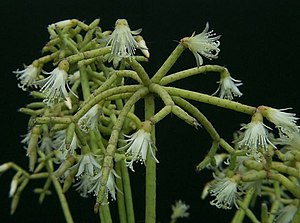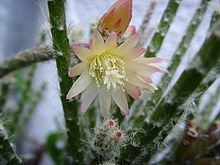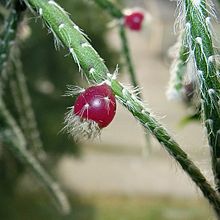Rhipsalis
| Rhipsalis | ||||||||||||
|---|---|---|---|---|---|---|---|---|---|---|---|---|

|
||||||||||||
| Systematics | ||||||||||||
|
||||||||||||
| Scientific name | ||||||||||||
| Rhipsalis | ||||||||||||
| Garden. |
Rhipsalis is a genus of plants from the cactus family(Cactaceae). The botanical name of the genus is derived from the Greek noun rhips for 'willow rod', 'willow weave ' and refers to the branched and interwoven thin shoots.
With Rhipsalis baccifera , the genus contains the only species of cactus that is distributed outside of America . Most species are native to the Atlantic rainforest in eastern Brazil . Rhipsalis is the most extensive genus with epiphytic growing cacti.
description
Vegetative characteristics
The species of the genus Rhipsalis grow shrubby epiphytic or rarely lithophytic with mostly hanging shoots . The often dimorphic segmented shoots are cylindrical and mostly twisting but occasionally also angular, ribbed or flat. New shoots almost always appear in the area of the shoot tips of older shoots (acrotonic branching). The areoles are small, thorns are mostly absent.
Generative characteristics
The small, usually white flowers are wheel-shaped and open during the day. Your pericarpel is round and mostly bare, but rarely has soft bristles. The flower tube is very short or completely absent.
The small, berry-like fruits are bare and contain shiny black-brown, smooth seeds .
genetics
The base chromosome number of the genus corresponds to that of all cactus plants.
distribution
The genus Rhipsalis is distributed throughout the tropics of the American continent and the Caribbean , but mostly in eastern Brazil . Rhipsalis baccifera is the only species native to tropical Africa from Madagascar to Sri Lanka on islands in the Indian Ocean .
Systematics
External system
Rhipsalis is classified within the cactus family in the tribe Rhipsalideae . Phylogenetic studies confirmed the monophyly of the genus and the classification in the tribe Rhipsalideae. In a study published by Nadja Korotkova and others at the end of 2011, the following relationships within the tribe Rhipsalideae were found:
| Rhipsalideae |
|
|||||||||||||||||||||||||||
|
|
Internal system

The first description of the genus was published by Joseph Gärtner in 1788 . According to Wilhelm Barthlott and Nigel Paul Taylor , the genus is divided into five sub-genera and includes the following species:
- Subgenus Calamorphipsalis K.Schum.
- Rhipsalis hoelleri Barthlott & NPTaylor
- Rhipsalis neves-armondii K.Schum.
- Rhipsalis puniceodiscus G. Lindb .
- Subgenus Epallagonium K.Schum.
- Rhipsalis dissimilis (G. Lindb.) K.Schum.
- Rhipsalis flagelliformis N.P. Taylor & Zappi
-
Rhipsalis floccosa Salm-Dyck ex Pfeiff.
- Rhipsalis floccosa subsp. floccosa
- Rhipsalis floccosa subsp. Hohenauensis (F.Ritter) Barthlott & NPTaylor
- Rhipsalis floccosa subsp. oreophila N.P. Taylor & Zappi
- Rhipsalis floccosa subsp. pittieri (Britton & Rose) Barthlott & NPTaylor
- Rhipsalis floccosa subsp. pulvinigera ( G. Lindb .) Barthlott & NPTaylor
- Rhipsalis floccosa subsp. tucumanensis (FACWeber) Barthlott & NPTaylor
-
Rhipsalis pacheco-leonis Loefgr.
- Rhipsalis pacheco-leonis subsp. pacheco-leonis
- Rhipsalis pacheco-leonis subsp. catenulata (Kimnach) Barthlott & NPTaylor
-
Rhipsalis paradoxa (Salm-Dyck ex Pfeiff.) Salm-Dyck
- Rhipsalis paradoxa subsp. paradox
- Rhipsalis paradoxa subsp. septentrionalis N.P. Taylor & Barthlott
- Rhipsalis pentaptera A Dietr.
- Rhipsalis sulcata F.AC Weber
- Rhipsalis trigona whistle.
- Subgenus Phyllarthrorhipsalis Buxb.
- Rhipsalis agudoensis N.P. Taylor
- Rhipsalis barthlottii Ralf Bauer & N.Korotkova
- Rhipsalis cereoides (Backeb. & Voll) Backeb.
- Rhipsalis crispata (Haw.) Whistle.
- Rhipsalis cuneata Britton & Rose
- Rhipsalis elliptica G. Lindb. ex K.Schum.
- Rhipsalis goebeliana Backeb.
- Rhipsalis micrantha (Kunth) DC.
- Rhipsalis oblonga Loefgr.
- Rhipsalis occidentalis Barthlott & Rauh
- Rhipsalis olivifera N.P. Taylor & Zappi
- Rhipsalis pachyptera whistle.
- Rhipsalis russellii Britton & Rose
- Subgenus Rhipsalis
-
Rhipsalis baccifera (JSMuell.) Stearn
- Rhipsalis baccifera subsp. baccifera
- Rhipsalis baccifera subsp. cleistogama M. Kessler & al.
- Rhipsalis baccifera subsp. erythrocarpa (K.Schum.) Barthlott
- Rhipsalis baccifera subsp. hileiabaiana N.P. Taylor & Barthlott
- Rhipsalis baccifera subsp. horrida (Baker) Barthlott
- Rhipsalis baccifera subsp. mauritiana (DC.) Barthlott
- Rhipsalis baccifera subsp. shaferi (Britton & Rose) Barthlott & NPTaylor
- Rhipsalis crispimarginata
- Rhipsalis ewaldiana Barthlott & NPTaylor
- Rhipsalis grandiflora Haw.
- Rhipsalis lindbergiana K.Schum.
- Rhipsalis mesembryanthemoides Haw.
- Rhipsalis teres (Vell.) Steud.
-
Rhipsalis baccifera (JSMuell.) Stearn
- Subgenus Erythrorhipsalis A. Berger
- Rhipsalis aurea M.F. Freitas & JMABraga
- Rhipsalis burchellii Britton & Rose
- Rhipsalis campos-portoana Loefgr.
- Rhipsalis cereuscula Haw.
- Rhipsalis clavata F.AC Weber
- Rhipsalis juengeri Barthlott & NPTaylor
- Rhipsalis ormindoi N.P. Taylor & Zappi
- Rhipsalis pilocarpa Loefgr.
- Rhipsalis pulchra Loefgr.
Among other things, the following names are of unclear use, but belong to this genus: Cereus platycarpus Zucc. (1837); Epiphyllum platycarpum Zucc. (1836), Rhipsalis platycarpa (Zucc.) Pfeiff. (1836); Hariota cribrata Lem. (1857, nom. Inval. ICBN -Article 11.4), Rhipsalis cribrata (Lem.) Rümpler (1886), Erythrorhipsalis cribrata (Lem.) Volgin (1981), Hatiora cribrata Lem. (1857, nom. Invalid ICBN -Article 61.1).
Synonyms of the genus are Hariota Adans. (1763), Erythrorhipsalis A. Berger (1920) and Hylorhipsalis Doweld (2002).
Botanical history

Development of the system
In 1771 Johann Sebastian Mueller described the first species of the genus Rhipsalis . However, Mueller classified it in the genus Cassytha from the laurel family (Lauraceae) and gave it the botanical name Cassyta baccifera . Seventeen years later, Joseph Gärtner recognized that the species represented an independent genus and described the new genus Rhipsalis for it . Mueller's Art was given the new name Rhipsalis cassytha . According to the rules of the International Code of Botanical Nomenclature , Gärtner's approach was not legitimate, since he had changed the specific epithet , although his description was based on the same type material as Mueller's first description . William Thomas Stearn therefore corrected the species name in 1939 to Rhipsalis baccifera .
In 1828, seven species were known to Augustin-Pyrame de Candolle . In 1837, Ludwig Georg Karl Pfeiffer classified the 16 species he listed according to the shape of the shoots into the four rows of Alatae (winged), Angulosae (angular), Teretes (round stalk) and Articuliferae (limb- bearing) and created the first questionable classification.
Wilhelm Barthlott and Nigel Paul Taylor divided the genre into five sub-genres in 1995.
Conservation of the generic name
Following a suggestion by Hermann August Theodor Harms and other botanists, a list of generic names was published in 1904 which, contrary to the priority principle accepted by botanists, should be preserved as a "nomen conservandum" due to their distribution. Among the generic names recommended by Harms was also the genus Rhipsalis , since the generic name Hariota, established by Michel Adanson in 1763 , would actually have had priority.
Harm's list was included in the proposals submitted to the Second International Botanical Congress, which met in Vienna in 1905 , and was accepted by the Congress. In preparation for the International Botanical Congress that took place in Cambridge in 1930, the list of "Nomina Generica Conservanda" was supplemented by Mary Letitia Green (1886–1978) by specifying the type species. Due to the death of John Isaac Briquet (1870–1931), the official text did not appear until February 1935. In 1960, the name published by Michel Adanson was finally rejected by Harold William Rickett (1896–1989) and Frans Antonie Stafleu (1921–1997) .
Danger
Appendix I of the Washington Convention on Endangered Species does not contain any species of the genus Rhipsalis . In the Red List of Threatened Species of IUCN , however, are ten species or subspecies listed with different threat status. Rhipsalis paradoxa subsp. septentrionalis is considered endangered. Rhipsalis baccifera subsp. Are classified as endangered . hileiabaiana , Rhipsalis cereoides , Rhipsalis crispata , Rhipsalis pilocarpa and Rhipsalis russellii . Rhipsalis oblonga is at risk . Rhipsalis elliptica , Rhipsalis floccosa and Rhipsalis paradoxa are not considered endangered . Insufficient data are available to assess the degree of endangerment of Rhipsalis hoelleri , Rhipsalis pacheco-leonis and Rhipsalis sulcata .
proof
literature
- Edward F. Anderson : The Great Cactus Lexicon . Eugen Ulmer KG, Stuttgart 2005, ISBN 3-8001-4573-1 , p. 567-577 .
- Wilhelm Barthlott, Nigel P. Taylor: Notes towards a Monograph of Rhipsalideae (Cactaceae) . In: Bradleya . Volume 13, 1995, pp. 43-79.
- Alice Calvente, Regina HP Andreata and Ricardo C. Vieira: Stem anatomy of Rhipsalis (Cactaceae) and its relevance for taxonomy . In: Plant Systematics and Evolution . Volume 276, number 3/4, pp. 271-277, doi : 10.1007 / s00606-008-0073-4 .
- Alice Calventea, Daniela C. Zappi, Lúcia G. Lohmann: A new subgeneric classification of Rhipsalis (Cactoidae, Cactaceae) . In: Alice Calventea: Molecular phylogeny, evolution and systematics of Rhipsalis (Cactaceae) . Dissertation, São Paulo 2010, pp. 101–116.
- Nadja Korotkova, Thomas Borsch, Dietmar Quandt, Nigel P. Taylor, Kai F. Müller, Wilhelm Barthlott: What does it take to resolve relationships and to identify species with molecular markers? An example from the epiphytic Rhipsalideae (Cactaceae) . In: American Journal of Botany . Volume 98, Number 9, 2011, pp. 1549-1572 ( doi: 10.3732 / ajb.1000502 ).
Individual evidence
- ↑ Alice Calventea, Daniela C. Zappi, Félix Forest, Lúcia G. Lohmann: Molecular phlogeny of the tribe Rhipsalideae (Cactaceae) and taxonomic implications for Schlumbergera and Hatiora . In: Molecular Phylogenetics and Evolution . Volume 58, number 3, 2011, pp. 456-468, DOI: 10.1016 / j.ympev.2011.01.001 .
- ↑ Nadja Korotkova, Thomas Borsch, Dietmar Quandt, Nigel P. Taylor, Kai F. Müller, Wilhelm Barthlott: What does it take to resolve relationships and to identify species with molecular markers? An example from the epiphytic Rhipsalideae (Cactaceae) . In: American Journal of Botany . Volume 98, Number 9, 2011, p. 1557 ( doi: 10.3732 / ajb.1000502 ).
- ^ Joseph Gärtner: De Fructibus et Seminibus Plantarum . Volume 1, 1788, pp. 137-138 ( online ).
- ^ W. Barthlott, NP Taylor: Notes towards a Monograph of Rhipsalideae (Cactaceae) . In: Bradleya . Volume 13, pp. 43-79, 1995
- ^ Edward F. Anderson : The great cactus lexicon . Eugen Ulmer KG, Stuttgart 2005, ISBN 3-8001-4573-1 , p. 568-577 .
- ↑ a b Maria de Fátima Freitas, Alice de Moraes Calvente and João Marcelo Alvarenga Braga: A New Species of Rhipsalis (Cactaceae) from Brazil . In: Systematic Botany , Volume 34, Number 3, 2009. pp. 505-509
- ↑ Nigel Taylor, Gerardus Olsthoorn, Daniela Zappi, Gillian Khew, Dietmar Quandt: A remarkable new Rhipsalis (Cactaceae) from eastern Brazil . In: Bradleya . Volume 32, 2014, pp. 2–12.
- ↑ Ralf Bauer, Nadja Korotkova: A new Rhipsalis from Brazil - Rhipsalis barthlottii . In: Cacti and other succulents . Volume 67, No. 11, 2016, pp. 281-287.
- ↑ Alice Calventea, Daniela C. Zappi, Lúcia G. Lohmann: Taxonomic revision of the "winged-stem clade" (Rhipsalis, Cactaceae) . In: Alice Calventea: Molecular phylogeny, evolution and systematics of Rhipsalis (Cactaceae) . Dissertation, São Paulo 2010, pp. 130-131.
- ↑ Illustratio Systematis Sexualis Linnaei . London 1771 ( online ).
- ↑ De fructibus et seminibus plantarum: Accedunt Seminum centuriae Quinque Priore . Volume 1, Stuttgart 1788, pp. 137-138 , panel XXVIII .
- ^ Cactus Journal . Volume 7, London 1939, p. 107.
- ↑ Augustin-Pyrame de Candolle: Prodromus systematis naturalis regni vegetabilis . Volume 3, 1828, pp. 475-476 (on- line ).
- ^ Ludwig Georg Karl Pfeiffer: Enumeratio Diagnostica Cactearum hucusque Cognitarum . Berlin 1837, pp. 129-137 ( online ).
- ^ Wilhelm Barthlott, Nigel P. Taylor: Notes towards a Monograph of Rhipsalideae (Cactaceae) . In: Bradleya . Volume 13, 1995, pp. 43-79.
- ^ H. Harms: Proposal to supplement the "Lois de la nomenclature botanique de 1867", recommended for adoption at the nomenclature congress that met in Vienna in 1905 . In: Notblatt des Königl. botanical garden and museum in Berlin. Volume 4, Appendix XIII, 1904, p. 27 ( JSTOR 3993987 )
- ↑ Michel Adanson: Familles des Plantes . Volume 2, Paris 1763, p. 243 ( online ).
- ↑ John Briquet: texts of documents synoptique destines A servir de base aux debats du Congres International de Nomenclature Botanique de Vienne 1905 . R. Friedlinder & Sohn, Berlin 1905, p. 146.
- ^ John Briquet: Règles internationales de la nomenclature botanique: adoptées par le Congrès International de Botanique de Vienne 1905 et publiées au nom de la commission de rédaction du congrès . Fischer, Jena 1906.
- ^ Mary Letitia Green: Proposed standard species of Nomina Generica Conservanda . In: International Botanical Congress Cambridge (England), 1930 Nomenclature Proposals by British Botanists . London 1929, p. 105 ( online )
- ↑ HW Rickett, FA Stafleu: Nomina generica conservanda et rejicienda spermatophytorum IV (Continued) . In: Taxon . Volume 9, Number 3, 1960, p. 68 ( JSTOR 1216832 ).
- ^ Dan H. Nicolson: E-Mail of January 29, 2004. In: Taxacom - Biological Systematics Discussion List (accessed April 23, 2010)
- ^ Entry on the genus Rhipsalis in the Proposals and Disposals database of the Department of Botany, National Museum of Natural History, Smithsonian Institution (accessed April 23, 2010)
- ^ Search for "Opuntia" in the IUCN 2012 Red List of Threatened Species . Accessed August 3, 2008.



